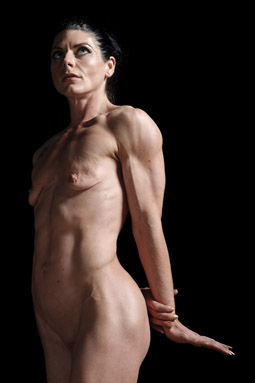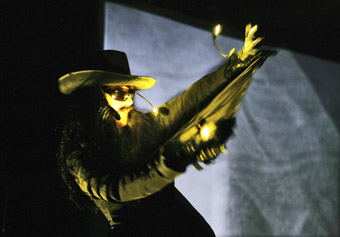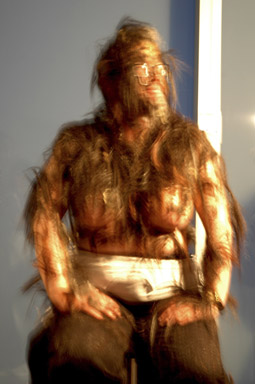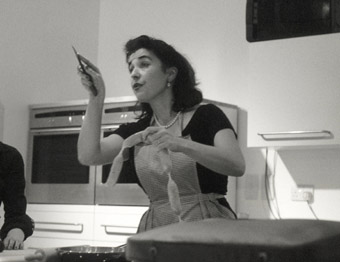together in the here & now
theron schmidt: the final national review of live art, glasgow

Francesca Steele, Routine
courtesy the artist
Francesca Steele, Routine
THE BELL THAT SOUNDS THE BEGINNING OF THE 30TH NATIONAL REVIEW OF LIVE ART ALSO SOUNDS THE BEGINNING OF THE END: THIS IS THE FESTIVAL’S FINAL INCARNATION IN ITS CURRENT FORM. THE BELL IS SWUNG BY JÜRGEN FRITZ, WHO, LIKE ALL THE ARTISTS IN THIS YEAR’S PROGRAM, HAS PLAYED A PART IN THE FESTIVAL’S HISTORY (HE IS ONE OF THE FOUNDING MEMBERS OF DURATIONAL PERFORMANCE GROUP BLACK MARKET INTERNATIONAL).
Fritz moves slowly at first, the bell making only dull thuds as his arm travels mere inches from his side, and it is several minutes before his swing has accelerated enough for a clear note to ring out. Gradually, carefully, the swings build in energy, until for 30 minutes or so he is swinging exuberantly, ecstatically, joyfully shaking the sweat from his forehead. As a squad of Scottish pipers join in, Fritz surrenders his whole being to the single act of ringing the bell, wildly swinging for love and country and art and folly.
It’s a perfect beginning to the festival, a gesture that both celebrates and says farewell to the NRLA. But at the same time, what is alluring is that it is only a gesture, one that Fritz repeats in different contexts and different cities (for example, in Brisbane in 2008, RT88). It is not for anything or because of anything, but simply the pure, repetitive action: it has a what and a when but no why. Over the five-day festival, densely packed with overlapping performances running from morning until late in the night, my memory accumulates many similar moments: gestures that are beautifully, powerfully meaningless. David Richmond touches his hand to his heart, extends his pinky finger, and raises it in the air. Sheila Ghelani turns to her audience, looks them in the eye, and licks her sugar-coated lips. Iona Kewney hurls and coils her body as dynamically and articulately as a pianist might move her fingers. Lee Wen, clutching a pair of pig’s feet, lowers his twisted frame to lap milk from the floor.
On this anniversary occasion, these gestures are like gifts rather than proclamations. They do not ask me to agree or disagree with them, but are invitations, offerings that I may choose to accept or refuse. Adding live video to a layering of film-within-film, Stephen Partridge’s hands dance furtively and playfully with images of themselves from the past. In the palm of my own hand, Helen Paris from Curious shows me a film in which she lies in the sea on an inflatable raft. Enclosed in a glass display case, Alastair MacLennan blows up balloons and makes gentle traces with his hands, wafting them effortlessly like a bat’s flight slowed down to a visible tremble. For hours he sits, his eyes closed, the case filling up with white balloons. The gesture of blowing up balloons is like an offering of breath, a wasting of space in honour of our being together.
Appropriately for the 30th anniversary, balloons are one of the recurring motifs of the festival. In another durational piece, Elvira Santamaría Torres methodically gathers air into white bin bags, bundling them together to float through the Arches’ vast spaces. At the end of his 30-hour occupation of one of the smaller performance spaces, Michael Mayhew leaves behind a glorious forest of multi-coloured balloons, several of which are carried out by spectators and continue to haunt the remaining events.
Alongside these intimate gestures are, of course, others on a bigger scale: more spectacular, more theatrical, more sensational. And accompanying these are some of the logistical problems that have unfortunately become familiar features of the NRLA over the years. Arriving at the box office at the advertised time to sign up for Ron Athey’s Self Obliterations, I’m told that all the slots were allocated two hours ago. As one of several hundred spectators gathered around Kira O’Reilly’s Untitled (syncope), I catch nothing but brief glimpses of her quivering and teetering body. Through a small window in the door, I peer at Yann Marussich’s Brisures and witness his slow, painstakingly beautiful emergence from a box of broken glass—but I know my experience is nothing like that of those who were at the front of the queue and who are now immersed in a carefully orchestrated world of light and throbbing sound.

Julia Bardsley, Aftermaths
Some of the other larger-scale events at the NRLA are restagings of works presented at other festivals; for example, Julia Bardsley’s AFTERMATHS and Forced Entertainment’s Void Story both premiered at London’s SPILL 09 (RT 91). The proliferation of other platforms for this kind of work is probably one reason why the NRLA is closing down in its present form. In the early 1980s there weren’t any other opportunities for work like this to be shown in the UK, and the NRLA evolved from the artist-initiated Performance Platform to be a regular event. Now there is SPILL and a reinvigorated LIFT in London, regional festivals such as Birmingham’s Fierce and Newcastle’s Wunderbar (RT95), artist-led initiatives such as the itinerant Forest Fringe and Bristol’s Residence, and regular support for Live Art from fixed venues such as Bristol’s Arnolfini, the Bluecoat in Liverpool, Cardiff’s Chapter Arts Centre, London’s Chelsea Theatre and the Colchester Arts Centre.

Oreet Ashery
courtesy the artist
Oreet Ashery
And yet, at this final NRLA, I’m aware of the kind of work that is uniquely possible in an environment such as this. It’s hard to imagine a different setting for work such as Oreet Ashery’s Hairoism, in which, over several hours, Ashery’s helpers glue scraps of hair to her shaved head in order to reproduce the characteristic hair styles and facial hair of a series of prominent male figures in the Israeli/Palestinian conflict. Because it is organised toward the production of precisely conceived images, the live element to this work might seem incidental, as if only the final product matters. But it is the live production of the images that makes this work so powerful: Ashery’s fixed, glassy stare and her wonderfully particular, sedentary body; the overwhelming barrage of documentary footage and news clips that fill the room; the silent presence of her deliberately caricatured helpers, collecting hair samples from the wandering audience; and, in fact, the material presence of the documentation of the image in the form of polaroids and simultaneous video feed of Ashery’s body-in-formation.
Likewise, the festival has always been a supportive environment for one-to-one performances, and one of the most powerful examples this year is Francesca Steele’s Routine. From the publicity information I learn that she has been training as a bodybuilder for over a year as her artistic practice. As I queue for over an hour for my five minutes with her, I have a pretty strong suspicion about what the encounter will be. This turns out to be exactly right: on entering the space, I am welcomed onto a small platform by a naked and silent Steele. Inches away from me and staring into my eyes, she moves her radically transformed, de-feminised body through a series of poses that display her lean musculature. Despite knowing exactly what to expect from the work, and despite my familiarity with these kinds of intimate artistic experiences, I leave the encounter palpably shaken, an unknown and untraceable energy working away inside my stomach and trembling in my hands and fingers.

Marica Farquhar
courtesy the artist
Marica Farquhar
Finally, one the most moving and life-affirming events of the festival is Marcia Farquhar’s The Omnibus. Farquhar announces that she will honour the NRLA’s 30 years by ruminating, non-stop, for 30 hours about the last 30 years of her life—during which time she raised her children, struggled with depression and returned to art school as a mature student. (Okay, so it didn’t actually turn out to be 30 hours; initially she planned to invite audience members to stay with her overnight in the theatre, but Health and Safety regulations dictated that members of the public had to vacate the building between 2am and 10am.)
Farquhar’s previous performances have been marked by her meandering, unabashedly self-critical and open-ended monologues. This durational format pushes her to a new extreme. Instinctively, she produces an extraordinary mash-up of two different etiquettes: that of a host in a social situation, and that of a performer in a theatre event. As audience members come and go, she interrupts whatever story she is in the middle of to bid each person goodbye, and cheerfully greets each new guest as if at a dinner party. Trying to catch each newcomer up on what the project is about and what has already been discussed, she is constantly stuttering, winding back to the beginning of the event, forgetting what she was talking about, and reconstructing the thread of the event even as it unravels.
As with the commemorative agenda of this final NRLA, there is a risk that simple nostalgia will dominate. But Farquhar grasps at distant memories, and the more recent past of this particular event, not in order to save the past from being lost but in order to be here now, together. And, despite announcing that she has no plans for a big finale at the end of the 30 hours, we find ourselves stumbling into one: on our feet, singing along to her Sex Pistols original 45 in unison: “No future, no future, no future for you.”
National Review of Live Art, The Arches and Tramway, Glasgow, March 17-21
RealTime issue #97 June-July 2010 pg. 8-9






